conversion转译法
- 格式:ppt
- 大小:219.00 KB
- 文档页数:23
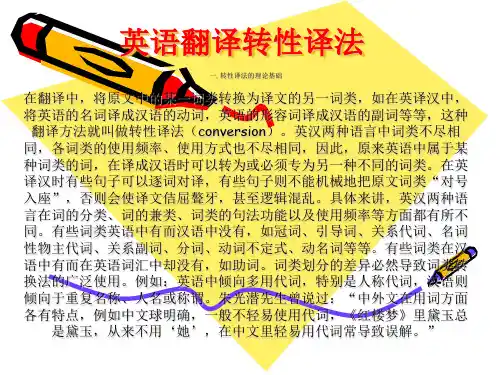
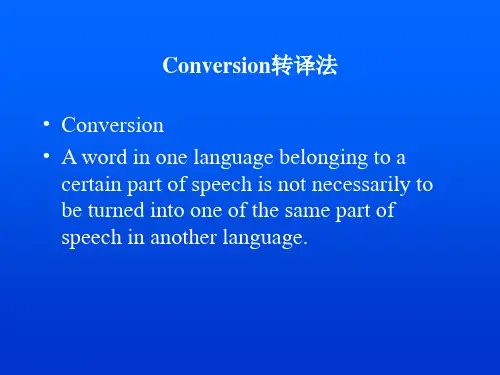
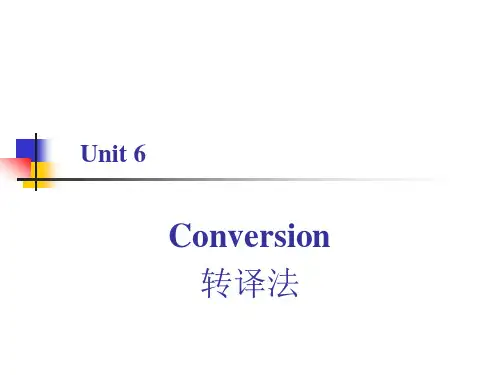
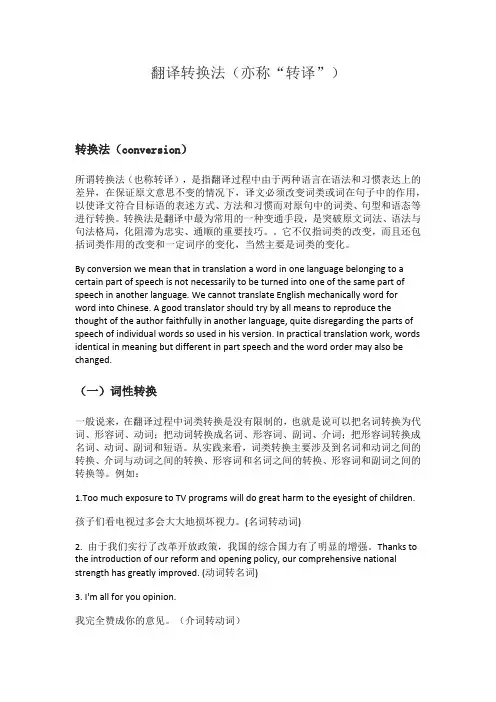
翻译转换法(亦称“转译”)转换法(conversion)所谓转换法(也称转译),是指翻译过程中由于两种语言在语法和习惯表达上的差异,在保证原文意思不变的情况下,译文必须改变词类或词在句子中的作用,以使译文符合目标语的表述方式、方法和习惯而对原句中的词类、句型和语态等进行转换。
转换法是翻译中最为常用的一种变通手段,是突破原文词法、语法与句法格局,化阻滞为忠实、通顺的重要技巧。
它不仅指词类的改变,而且还包括词类作用的改变和一定词序的变化,当然主要是词类的变化。
By conversion we mean that in translation a word in one language belonging to a certain part of speech is not necessarily to be turned into one of the same part of speech in another language. We cannot translate English mechanically word for word into Chinese. A good translator should try by all means to reproduce the thought of the author faithfully in another language, quite disregarding the parts of speech of individual words so used in his version. In practical translation work, words identical in meaning but different in part speech and the word order may also be changed.(一)词性转换一般说来,在翻译过程中词类转换是没有限制的,也就是说可以把名词转换为代词、形容词、动词;把动词转换成名词、形容词、副词、介词;把形容词转换成名词、动词、副词和短语。

翻译转换法(亦称“转译”)转换法(conversion)所谓转换法(也称转译),是指翻译过程中由于两种语言在语法和习惯表达上的差异,在保证原文意思不变的情况下,译文必须改变词类或词在句子中的作用,以使译文符合目标语的表述方式、方法和习惯而对原句中的词类、句型和语态等进行转换。
转换法是翻译中最为常用的一种变通手段,是突破原文词法、语法与句法格局,化阻滞为忠实、通顺的重要技巧。
它不仅指词类的改变,而且还包括词类作用的改变和一定词序的变化,当然主要是词类的变化。
By conversion we mean that in translation a word in one language belonging to a certain part of speech is not necessarily to be turned into one of the same part of speech in another language. We cannot translate English mechanically word for word into Chinese. A good translator should try by all means to reproduce the thought of the author faithfully in another language, quite disregarding the parts of speech of individual words so used in his version. In practical translation work, words identical in meaning but different in part speech and the word order may also be changed.(一)词性转换一般说来,在翻译过程中词类转换是没有限制的,也就是说可以把名词转换为代词、形容词、动词;把动词转换成名词、形容词、副词、介词;把形容词转换成名词、动词、副词和短语。
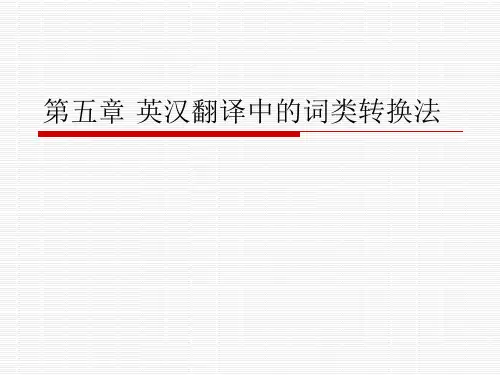
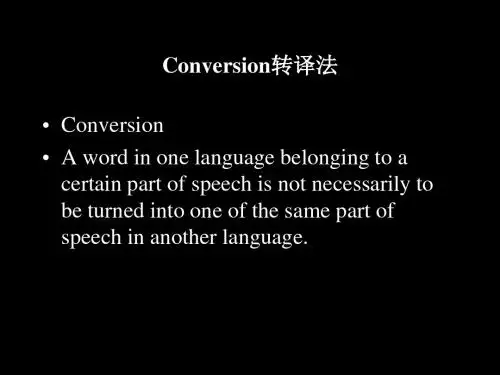
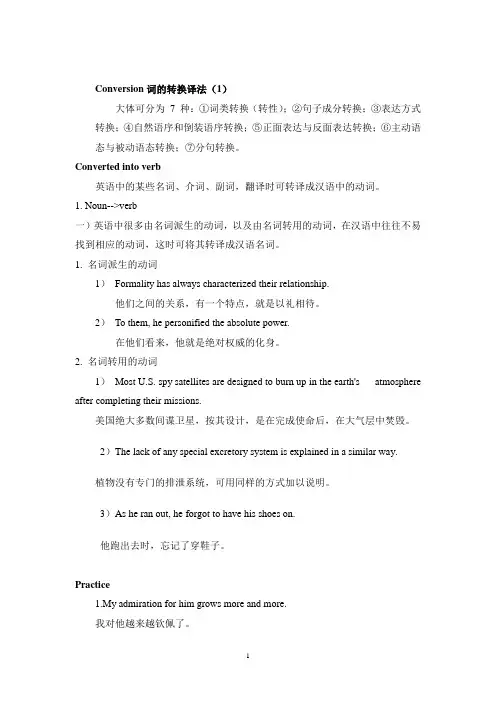
Conversion词的转换译法(1)大体可分为7 种:①词类转换(转性);②句子成分转换;③表达方式转换;④自然语序和倒装语序转换;⑤正面表达与反面表达转换;⑥主动语态与被动语态转换;⑦分句转换。
Converted into verb英语中的某些名词、介词、副词,翻译时可转译成汉语中的动词。
1. Noun-->verb一)英语中很多由名词派生的动词,以及由名词转用的动词,在汉语中往往不易找到相应的动词,这时可将其转译成汉语名词。
1. 名词派生的动词1)Formality has always characterized their relationship.他们之间的关系,有一个特点,就是以礼相待。
2)To them, he personified the absolute power.在他们看来,他就是绝对权威的化身。
2. 名词转用的动词1)Most U.S. spy satellites are designed to burn up in the earth's atmosphere after completing their missions.美国绝大多数间谍卫星,按其设计,是在完成使命后,在大气层中焚毁。
2)The lack of any special excretory system is explained in a similar way.植物没有专门的排泄系统,可用同样的方式加以说明。
3)As he ran out, he forgot to have his shoes on.他跑出去时,忘记了穿鞋子。
Practice1.My admiration for him grows more and more.我对他越来越钦佩了。
2.An acquaintance of world history is helpful to the studies of current affairs.了解世界历史对研究时事很有帮助。


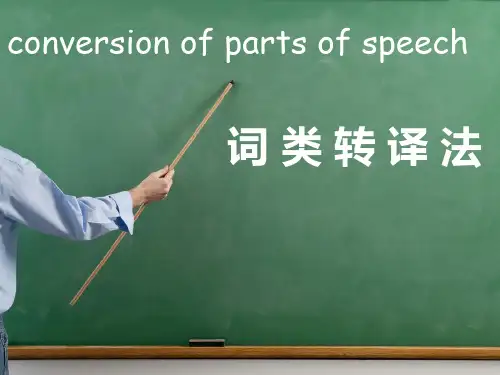
"转换"、"转变"、"变换"、"革新"都可以翻译为conversion。
下面我会对这几种译法进行详细解释并举例说明:1. "转换":这是一个很通用的译法,通常用于表示将一种形式或状态转变为另一种形式或状态。
例如,我们可以说"将数据从一种格式转换为另一种格式"或者"将能源从一种形式转换为另一种形式"。
2. "转变":这个译法通常用于表示重大的、根本性的变化。
它强调的是从一个极端到另一个极端的转变,例如从贫穷到富裕,从消极到积极等。
3. "变换":这个译法强调的是在一定范围内或条件下的变化。
它可能是在同一性质或同一类别下的变化,例如在不同的季节或天气条件下,人们所穿的衣服会有所变换。
4. "革新":这个译法通常用于表示通过创新或改进而实现的变化。
它可能涉及到技术、方法、流程等方面的改变,例如新的生产方法、新的管理理念等。
在具体的使用场景中,这些译法可能会有所不同。
例如,如果涉及到物理设备的转换,我们可能会选择使用"转换"或"革新"。
如果涉及到商业或技术的改变,我们可能会选择"转变"或"变换"。
但是这些译法并非绝对,具体情况还需要根据上下文和语境来判断。
除此之外,还有"转译"、"转业"、"转型"、"转向"等说法,都可以表示某种变化或转变,但具体含义可能会因语境而异,需要具体分析。
以上是对conversion的各种译法的解释和举例,希望对你有所帮助。